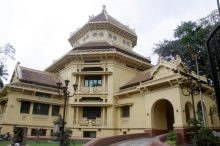Vietnam National Museum of History

 The Vietnam National Museum of History is a public institution established in 2011 through the amalgamation of the former National Museum of Vietnamese History and National Museum of the Vietnamese Revolution.
The museum is now housing over 200,000 objects and materials which are relics of Vietnamese history flowing from pre-history to the present. Among these, many are Vietnamese antiquities and 18 are recognized as Vietnam's national treasures.
The permanent public display of the Vietnam National Museum of History is located in a 3,700m2 exhibition space consisting of two adjoining buildings. The first of these twin structures is located at 1 Trang Tien Street, Hanoi: this fine historic building houses the displays and collections relating to Vietnam’s history from the prehistoric period to the end of the Nguyen Dynasty in 1945. The second site is at 216 Tran Quang Khai Street, and its displays showcase the history of Vietnam from the mid-19th century to the present day.
Museum Building A of the Vietnam National Museum of History, at No 1 Trang Tien Street (the Former National Museum of Vietnamese History), was originally the Louis Finot Museum, constructed in 1926 and inaugurated in 1932. The Museum building was designed as a major landmark of great architectural distinction, combining Eastern architectural elements in harmonious fusion with Western aesthetic features. In its original form, the Museum was a major showcase of Eastern Arts, including archaeological, ethnological and fine art collections from Vietnam and Asian countries.
In 1958, the Vietnamese government took over this important cultural foundation. It took five months of preparation and transformation to change the displays from what had been a broad overview of Asian Arts and artefacts to a sequence of displays on the rich story of Vietnam’s cultural life and development from prehistoric to modern times. On 3 September 1958, the National Museum of Vietnamese History was opened to the public.
The building at 216 Tran Quang Khai street (the former National Museum of the Vietnamese Revolution) was constructed in 1917 as the headquarters of the Indochina Department of Trade. In 1954, when the North was liberated, the Government Council led by President Ho Chi Minh decided to transform this building into a new Museum of the Vietnamese Revolution, which would showcase Vietnamese history from the mid 19th century to the present day. After 5 years of planning and development, the Museum was officially opened to the public on 6 January 1959.
Permanent collection:
The Vietnam National Museum of History is a public institution established in 2011 through the amalgamation of the former National Museum of Vietnamese History and National Museum of the Vietnamese Revolution.
The museum is now housing over 200,000 objects and materials which are relics of Vietnamese history flowing from pre-history to the present. Among these, many are Vietnamese antiquities and 18 are recognized as Vietnam's national treasures.
The permanent public display of the Vietnam National Museum of History is located in a 3,700m2 exhibition space consisting of two adjoining buildings. The first of these twin structures is located at 1 Trang Tien Street, Hanoi: this fine historic building houses the displays and collections relating to Vietnam’s history from the prehistoric period to the end of the Nguyen Dynasty in 1945. The second site is at 216 Tran Quang Khai Street, and its displays showcase the history of Vietnam from the mid-19th century to the present day.
Museum Building A of the Vietnam National Museum of History, at No 1 Trang Tien Street (the Former National Museum of Vietnamese History), was originally the Louis Finot Museum, constructed in 1926 and inaugurated in 1932. The Museum building was designed as a major landmark of great architectural distinction, combining Eastern architectural elements in harmonious fusion with Western aesthetic features. In its original form, the Museum was a major showcase of Eastern Arts, including archaeological, ethnological and fine art collections from Vietnam and Asian countries.
In 1958, the Vietnamese government took over this important cultural foundation. It took five months of preparation and transformation to change the displays from what had been a broad overview of Asian Arts and artefacts to a sequence of displays on the rich story of Vietnam’s cultural life and development from prehistoric to modern times. On 3 September 1958, the National Museum of Vietnamese History was opened to the public.
The building at 216 Tran Quang Khai street (the former National Museum of the Vietnamese Revolution) was constructed in 1917 as the headquarters of the Indochina Department of Trade. In 1954, when the North was liberated, the Government Council led by President Ho Chi Minh decided to transform this building into a new Museum of the Vietnamese Revolution, which would showcase Vietnamese history from the mid 19th century to the present day. After 5 years of planning and development, the Museum was officially opened to the public on 6 January 1959.
Permanent collection:
- Collection on Viet Nam in the Prehistoric Times (c. 400,000 – 300,000 to 4,000 BP.)
- Collection on Viet Nam in the Early Stage of Nation Building (c. 4,000 BP to the 3rd century BC.)
- Viet Nam from the 1st to the 10th century AD.
- Viet Nam from the 10th to the Mid-20th century AD, including: + Ngo – Dinh – Early Le Dynasties (938 – 1009 AD.) + Ly – Tran Dynasties (1009 – 1400 AD.) + Ho Dynasties (1400 – 1407 AD.) + Le – Mac – Restored Le Dynasties (1428 – 1788 AD.) + Tay Son Dynasties (1778 – 1802 AD.) + Nguyen Dynasties (1802 – 1945 AD.)
- Collection of Artifacts from the Early 20th century
- Collection of Champa Stone Sculpture (from 7th to 13th century AD.)
- Collection of the Oc Eo – Phu Nam Cultures (from 5th to 13th century AD.)
- The struggles for independence of the Vietnamese people (1858-1945)
- Thirty years of resistance against foreign invaders to sustain independence and unify the country (1945-1975)
- Viet Nam on the path to building a prosperous people, strong country, and a fair, democratic and civilised society (1976 to present)
- Gifts from the Vietnamese people and international friends of Viet Nam to President Ho Chi Minh and the Communist Party of Viet Nam
- Outdoor collection
View all Asia-Europe Museum Network (ASEMUS) members in Viet Nam
Similar content
10 Jan 2017 - 31 May 2017
posted on
09 Oct 2013
from - to
16 May 2012 - 27 May 2012
posted on
25 Jun 2012
04 Sep 2014 - 06 Sep 2014

